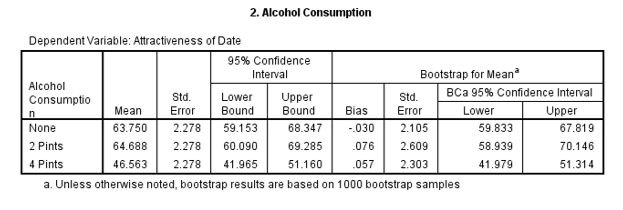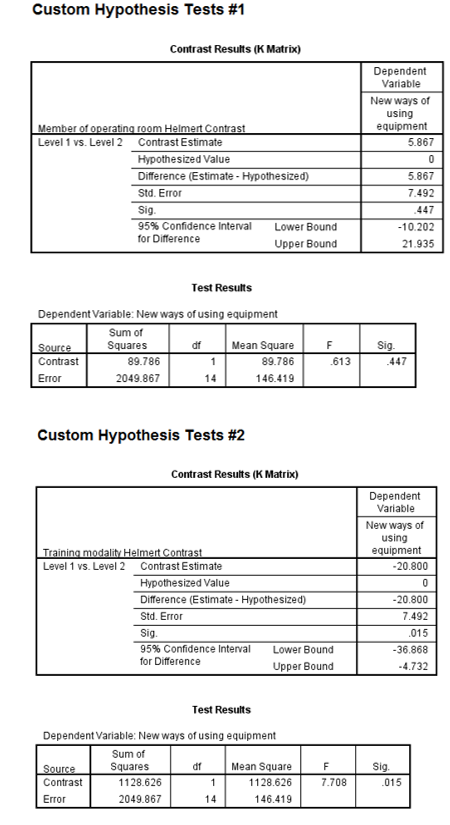Running ANOVA on SPSS
Replication of Analysis
Statistical test. Factorial ANOVA.
The problem the data set is based on. The independent variables are gender and consumption of alcohol while the dependent variable is the attractiveness of a mate.
Research question
Do gender and alcohol consumption influence the attractiveness of a date?
Hypotheses
There are several hypotheses because the question is investigating the effect of more than one independent variable. Let the effect of the first independent variable be denoted by A, the effect of the second independent variable be denoted by B. The first null hypothesis is based on the main effect (Carlson & Winquist, 2017): there is no significant difference in the attractiveness of a date based on gender (Ho: A=0).
The second null hypothesis is based on the second main effect: there is no significant difference in the attractiveness of a date based on the amount of alcohol consumed (Ho: B=0). The third null hypothesis is based on the effect of interaction between the first and second main effects (Jackson, 2012): there is no significant interaction effect between gender and alcohol consumption in terms of the attractiveness of a date (Ho: A+B=0).
Results
There was a significant main effect of alcohol (p˂0.05), which showed that the amount of alcohol consumed had a significant effect on whom the subject would engage in a conversation. The implication of this finding was that when the gender of the participant was disregarded, the amount of alcohol inspired their choice of mate. Levene’s test was not significant (p=0.202) implying that the variance in attractiveness is equal across the different groupings of gender and alcohol. Output 3 showed that there was a significant effect of alcohol (F=20.065, p˂0.001 on the attractiveness of a date (Field, 2013).
The effect of gender was not significant (F=2.032, p=0.161) implying that overlooking how much alcohol was taken, the gender of the subject did not affect the attractiveness of the partner that was chosen. Other factors held constant, males and females selected attractive mates. The interaction between the effect of gender and the effect of alcohol was significant (F=11.911, p˂0.001). The Bonferroni post hoc (Output 8) tests showed that that the subjects chose equally attractive mates when they took no alcohol or 2 pints of alcohol (p = 1.00) (Field, 2013).
Nevertheless, significantly less attractive mates were chosen after consumption of 4 pints of alcohol than after taking 2 pints (p < 0.001) and no alcohol (p < 0.001). The REGWQ test (Output 9) verifies that the means of the control and 2 pints situations were equal, whereas the mean of the 4-pints group was different.











Application of Factorial ANOVA on the Research Problem
In the research problem, the subjects were either surgeons (coded as 1) or other members of the surgical department such as nurses and anesthetists (coded as 2). All employees underwent either intensive classroom training or hands-on training . Factorial ANOVA compares means when we have 2 or more independent variables. There are two independent variables: healthcare roles (surgeon or other members of the surgical department) and training modality.
Problem 1
What form of training is more effective in the training of staff members on the utilization of the equipment? Why?
Statistical test. Factorial ANOVA.
The problem. The two independent variables are healthcare roles and mode of training, whereas the dependent variables are training of staff members on the utilization of the equipment.
Research question
Do health care roles and training modality affect the training of staff members on the utilization of the equipment?
Hypotheses. Ho: A=0, Ho: B=0, and Ho: A+B=0.
Results
Post hoc tests and contrasts were not conducted for health care roles and training modality because these variables only had two factors. Levene’s test was not significant (p=0.448) implying that the distribution of the variance of the two factors was equal Carlson & Winquist, 2017). The effect of membership was not significant (F=0.854, p=0.371), whereas the effect of training modality on the utilization of equipment was significant (F=22.027, p˂0.001). The effect of the interaction between membership and training modality was not significant (F=1.059, p=0.321).



Problem 2
How does the intervention correlate with the frequency of the use of technology, patients’ satisfaction, as well as the quality of services provided?
Statistical test. Factorial ANOVA.
The problem
Factorial ANOVA is only used to compare differences when there is more than one independent variable. However, when the dependent variables are more than one multiple ANOVAs are appropriate (Elliott & Woodward, 2014; Hahs-Vaughn & Lomax, 2013). In this case, there are three dependent variables (the frequency of the use of technology, patients’ satisfaction, and the quality of services provided). Therefore, three different factorial ANOVAs will be performed.
Research question 1
Do health care roles and training modality affect the training of staff members on the frequency of technology use?
Hypotheses. Ho: A=0, Ho: B=0, and Ho: A+B=0.
Results
Post hoc tests and contrasts were not conducted for health care roles and training modality because these variables only had two factors (Jackson, 2012). Levene’s test was not significant (p=0.662) implying that the variances of the two factors were equal. The effect of membership was not significant (F=0.196, p=0.665), whereas the effect of training modality on the utilization of equipment was significant (F=5.482, p=0.035). The effect of the interaction between membership and training modality on the frequency of technology use was not significant (F=0.667, p=0.424).


Research question 2
Do health care roles and training modality affect the training of staff members on patients’ satisfaction?
Hypotheses. Ho: A=0, Ho: B=0, and Ho: A+B=0.
Results
Post hoc tests and contrasts were not conducted for health care roles and training modality because these variables only had two factors. Levene’s test was not significant (p=0.432) showing that the variances of the two factors were equal. The effect of membership was not significant (F=0.007, p=0.934). Additionally, the effect of training modality on patient satisfaction was not significant (F=0.296, p˂0.595). The effect of the interaction between membership and training modality on patient satisfaction was also not significant (F=0.928, p=0.352).


Research question 3
Do health care roles and training modality affect the training of staff members on the quality of services provided?
Hypotheses. Ho: A=0, Ho: B=0, and Ho: A+B=0.
Results
Post hoc tests and contrasts were not conducted for health care roles and training modality because these variables only had two factors. Levene’s test was not significant (p=0.4062) signifying that the variances of the two factors were equally distributed. The effect of membership was significant (F=9.114, p=0.009), whereas the effect of training modality on the quality of services rendered was not significant (F=0.180, p=0.678). The effect of the interaction between membership and training modality on the quality of services was not significant (F=0.011, p=0.917). The Helmert contrast for membership of the surgical department was significant (p=0.009), which implied that the role of employee in the surgical department influenced the quality of services provided.



Problem 3
How does the intervention affect the participants’ willingness to implement their own research or find new ways of utilizing the equipment?
Statistical test. Factorial ANOVA.
The problem
There are two dependent variables (willingness to implement their own research and willingness to find new ways of utilizing the equipment), which means that there is a need to conduct two separate factorial ANOVAs given the limitations of factorial ANOVA (Terrell, 2012).
Research question 1
Do health care roles and training modality affect the participants’ willingness to implement their own research?
Hypotheses. Ho: A=0, Ho: B=0, and Ho: A+B=0.
Results
Post hoc tests and contrasts were not conducted for health care roles and training modality because these variables only had two factors. Levene’s test was not significant (p=0.707) implying that the variances of the two independent variables were equal. The effect of membership was slightly significant (F=4.783, p=0.046), whereas the effect of training modality on the subjects’ willingness to implement their own research was not significant (F=0.431, p=0.522). The effect of the interaction between membership and training modality on the participants’ willingness to implement their own research was not significant (F=0.161, p=0.694).




Research question 2
Do health care roles and training modality affect the participants’ willingness to find new ways of utilizing the equipment?
Hypotheses. Ho: A=0, Ho: B=0, and Ho: A+B=0.
Results
Post hoc tests and contrasts were not conducted for health care roles and training modality because these variables only had two factors. Levene’s test was not significant (p=0.370) implying that the variances of the two factors were equal. The effect of membership was not significant (F=0.613, p=0.447) while the effect of training modality on new ways of utilizing the equipment was significant (F=7.708, p=0.015). The combined effect (interaction) of membership and training modality on the respondents’ willingness to implement their own research was not significant (F=3.593, p=0.079).



Problem 4
How does the intervention affect the participants’ willingness to affect the hospital’s performance as well as certain purchasing policies?
Statistical test. Factorial ANOVA.
The problem
The dependent variable is the subjects’ willingness to affect the hospital’s performance as well as certain purchasing policies, whereas the independent variables are healthcare roles and training modality.
Research question
Do health care roles and training modality affect the participants’ willingness to affect the hospital’s performance as well as certain purchasing policies?
Hypotheses. Ho: A=0, Ho: B=0, and Ho: A+B=0.
Results
Post hoc tests and contrasts were not conducted for health care roles and training modality because these variables only had two factors. Levene’s test was not significant (p=0.700) implying that the variances of the two factors were equal. The effect of membership was not significant (F=0.048, p=0.831). The effect of training modality on the participants’ willingness to affect the hospital’s performance as well as certain purchasing policies was also not significant (F=1.189, p=0.294). The effect of the interaction between membership and training modality on the outcomes was not significant (F=0.048, p=0.831).




References
Carlson, K. A., & Winquist, J. R. (2017). An introduction to statistics: An active learning approach. Los Angeles, CA: Sage Publications.
Elliott, A. C., & Woodward, W. A. (2014). IBM SPSS by example: A practical guide to statistical data analysis (2nd ed.). Thousand Oaks, CA: Sage Publications.
Field, A. P. (2013). Discovering statistics using IBM SPSS statistics. Web.
Hahs-Vaughn, D. L., & Lomax, R. G. (2013). An introduction to statistical concepts (3rd ed.). New York, NY: Routledge.
Jackson, S. J. (2012). Research methods and statistics: A critical thinking approach (4th ed.). Belmont, CA: Cengage Learning.
Terrell, S. R. (2012). Statistics translated: A step-by-step guide to analyzing and interpreting data. New York, NY: Guilford Press.